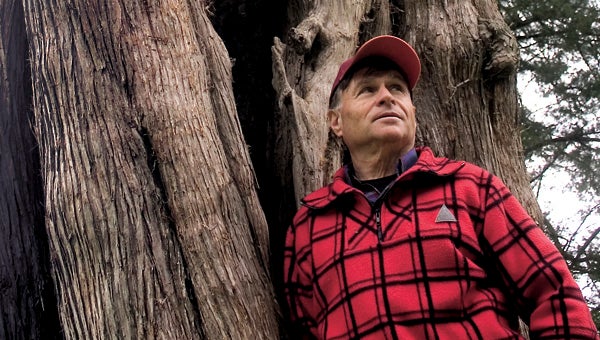Big tree legend
Published 11:54 pm Thursday, March 22, 2012

Byron Carmean shows off an unusual tree he found, a red cedar with a black cherry growing through the middle of it.
The legend goes that Byron Carmean can spot a champ from the highway at 60 miles per hour.
He acknowledges it’s partially true. He can identify the species — “I can probably do it 90 percent of the time and get it right,” he said — but every legend has its limit. He actually has to get out of the car to make sure it’s a champion.
Carmean and his traveling partner, usually Gary Williamson, spend their spare time criss-crossing Virginia and North Carolina looking for champions. They trek into old cemeteries, nature preserves, small towns, plantations and swamps in search of the largest trees of each species in the state.
It’s an obsession that was sparked in his horticulture and forestry background but never really caught fire until about 30 years ago, when he saw a Virginia forestry magazine that listed the biggest trees in the state.
He looked out the window and saw one he knew was bigger.
“We nominated that one,” he said. “It all started in ’83.”
He has found about 45-50 current state champions, making him the holder of more records than anyone else in the United States. Several of the state champs are in Suffolk. Some that he’s found — including one in Suffolk — currently are recognized as national champions.
Before he was letting the trees teach him, he was teaching about trees. He taught horticulture and forestry in Chesapeake for 21 years after earning his degree at Virginia Tech. He added another 10 years in alternative education before he retired.
Now that his teaching days are over, he has plenty of time to go in search of trees.
It’s not only big trees that he’s found. In his travels, he also has found many unusual trees, including one in Cedar Hill Cemetery. One of the cemetery’s trademark red cedars has a black cherry growing up through the middle of its trunk and out of its eastern side.
But big trees are his passion. He plans out his trips weeks in advance — gathering tips on where there might be a champ, tracing his route and contacting arborists in the area to ask for help. Often, they can give him tips on where to find champions. Sometimes, they even take him to the trees.
Finding champs doesn’t always require traveling, though. His hometown of Suffolk has 29 trees listed on the Virginia Big Tree Database, which honors the top five of each species.
The biggest Quercus mysinefolia, Chinese evergreen oak, in the state is in the front yard of a private residence on West Washington Street. Just next door, in the back yard, is the largest slash pine, or Pinus elliotti, in the state.
One of Carmean’s national champs, currently the only one from Suffolk, is on Babbtown Road near its intersection with White Marsh Road. The bigleaf snowbell, or Styrax grandifolius, isn’t as big as its name would suggest. It’s only 20 inches around the trunk and 17 feet tall, but that’s pretty large for such a tree.
“You’ve got to be intimately in touch with what is big for a particular species,” Carmean said.
That also requires knowing how well a particular species can be expected to do in Virginia. A coast redwood growing behind R.W. Baker Funeral Home is one of the biggest in the state, but it’s practically a sapling compared to those in California.
Robert Baker’s mother dug it up in California in 1954 and brought it to Suffolk.
“It looked like a fishing pole,” he said.
Since then, the tree has grown so that it rivals one at the Norfolk Botanical Gardens for the state’s top spot. Baker has watched it during several hurricanes from the back of the funeral home, willing it to stay in place as it swayed with the wind.
The top of it has died twice, but it always comes back healthy.
“It’s on the edge of hardiness here, but it does survive,” Carmean said.
On this day, he measures it for the first time in several years. The measurements are standardized throughout the nation so all trees can be compared to teach other.
First, Carmean gathers a large tape measure out of his bag and strings it around the trunk four and a half feet from the ground. It’s 16 feet, 7 inches around. He converts that to inches to get 199 inches.
Next, Carmean needs to find the height of the tree. He measures out 100 feet from the trunk and uses a clinometer to measure the distance from where he’s standing to the topmost part of the tree. Now that he knows two sides of the triangle, he can figure out the third with a bit of simple algebra — 87 feet high.
For the final part of the measurement, he needs to find the crown spread, the width of the branches. He measures from the longest branch on one side to the longest on the other, then repeats the process at a right angle to the other measurement. He averages the two — 40 and 43 feet — divides by four, and rounds down to get 10.
Adding the three together — 199 + 87 + 10 — he gets 296, a disappointing one point shy of the Norfolk tree.
“This was the state record for a while, then they got all jealous,” he said. “But we’re never going to beat the ones in California.”
Carmean said he doesn’t see himself giving up his hobby anytime soon.
“We just keep finding more champs and having more fun,” he said.






